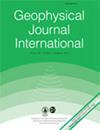Observations from the Seafloor: Ultra-low-frequency ambient ocean-bottom nodal seismology at the amendment field
IF 2.8
3区 地球科学
Q2 GEOCHEMISTRY & GEOPHYSICS
引用次数: 0
Abstract
Summary Large-scale ocean-bottom node (OBN) arrays of 1000s of multi-component instruments deployed over 1000s of square kilometers have been used successfully for active-source seismic exploration activities including full waveform inversion (FWI) at exploration frequencies above about 2.0 Hz. The analysis of concurrently recorded lower-frequency ambient wavefield data, though, is only just beginning. A key long-term objective of such ambient wavefield analyses is to exploit the sensitivity of sub-2.0 Hz energy to build long-wavelength initial elastic models, thus facilitating FWI applications. However, doing so requires a more detailed understanding of ambient wavefield information recorded on the seafloor, the types, frequency structure and effective source distribution of recorded surface-wave modes, the near-seafloor elastic model structure, and the sensitivity of recorded wave modes to subsurface model structure. To this end, we present a wavefield analysis of low- and ultra-low-frequency ambient data (defined as <1.0 Hz and <0.1 Hz, respectively) acquired on 2712 OBN stations in the Amendment Phase 1 survey covering 2750 km2 of the Gulf of Mexico. After applying ambient data conditioning prior to cross-correlation and seismic cross-coherence interferometry workflows, we demonstrate that the resulting virtual shot gather (VSG) volumes contain evidence for surface-wave and guided P-wave mode propagation between the 0.01-1.0 Hz that remains coherent to distances of at least 80 km. Evidence for surface-wave scattering from near-surface salt-body structure between 0.35-0.85 Hz is also present in a wide spatial distribution of VSG data. Finally, the interferometric VSG volumes clearly show waveform repetition at 20 s intervals in sub-0.3 Hz surface-wave arrivals, a periodicity consistent with the mean active-source shot interval. This suggests that the dominant contribution of surface-wave energy acquired in this VSG frequency band is likely predominantly related to air-gun excitation rather than by naturally occurring energy sources. Overall, these observations may have important consequences for the early stages of initial model building for elastic FWI analysis.海底观测:修正场超低频率环境洋底节点地震学
摘要 由部署在 1000 平方公里范围内的 1000 多台多分量仪器组成的大规模海底节点(OBN)阵列已成功用于主动源地震勘探活动,包括勘探频率高于约 2.0 Hz 的全波形反演(FWI)。不过,对同时记录的低频环境波场数据的分析才刚刚开始。这类环境波场分析的一个主要长期目标是利用 2.0 赫兹以下能量的敏感性来建立长波长初始弹性模型,从而促进 FWI 的应用。然而,要做到这一点,需要更详细地了解海底记录的环境波场信息,记录的面波模式的类型、频率结构和有效源分布,近海底弹性模型结构,以及记录的波模式对次表层模型结构的敏感性。为此,我们对第一阶段修正勘测中获得的 2712 个 OBN 站的低频和超低频环境数据(分别定义为 1.0 Hz 和 0.1 Hz)进行了波场分析,覆盖墨西哥湾 2750 平方公里。在交叉相关和地震交叉相干干涉测量工作流程之前应用环境数据调节后,我们证明所产生的虚拟地震波集(VSG)卷包含 0.01-1.0 Hz 之间面波和导波 P 波模式传播的证据,其相干性至少保持到 80 千米的距离。在 VSG 数据的广泛空间分布中,还存在 0.35-0.85 Hz 之间近表面盐体结构的面波散射证据。最后,VSG 干涉测量数据卷清楚地显示,在低于 0.3 赫兹的面波到达中,每隔 20 秒就有一次波形重复,这种周期性与活动源的平均发射间隔一致。这表明,在这一 VSG 频段获得的面波能量的主要贡献可能主要与气枪激发有关,而不是自然产生的能量源。总之,这些观察结果可能会对弹性 FWI 分析的初始模型建立的早期阶段产生重要影响。
本文章由计算机程序翻译,如有差异,请以英文原文为准。
求助全文
约1分钟内获得全文
求助全文
来源期刊

Geophysical Journal International
地学-地球化学与地球物理
CiteScore
5.40
自引率
10.70%
发文量
436
审稿时长
3.3 months
期刊介绍:
Geophysical Journal International publishes top quality research papers, express letters, invited review papers and book reviews on all aspects of theoretical, computational, applied and observational geophysics.
 求助内容:
求助内容: 应助结果提醒方式:
应助结果提醒方式:


